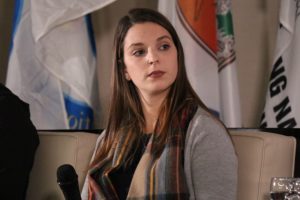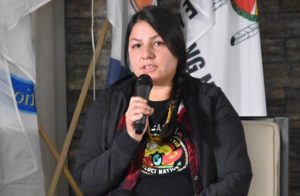A better future with strength of youth and wisdom of the Elders

By Kelly Anne Smith
NORTH BAY—Three Elders and three youth called on Indigenous peoples to support the youth as they strive to protect Mother Earth and her languages and to listen to the wisdom of Elders.
They were part of an Elders and Youth discussion panel at the Anishinabek Nation Lands and Resources Forum: Everything is Connected, held recently in North Bay on Nov. 6-8. The importance of treaties, culture and language were considered, as was technology in furthering education and awareness in communities.
Brittany Moses is a member of Biigtigong Nishnaabeg and is the Environmental Coordinator with the Department of Sustainable Development of Biigtigong Nishnaabeg. Moses urges the use of social media to engage youth.
“The most effective strategy to reach youth on and off reserve is through the use of technology and by engaging them in lands and resources activities. We want to let them know that the knowledge they bring to the table is important and valuable.”
Moses says that over the past seven or eight years, Biigtigong Nishnaabeg has been developing a land-based curriculum.
“The students are responding very well to that.”
Biigtigong Nishnaabeg had two students working as environmental monitors through a restructured summer student program.
“They participated in on-site tours. We went to different exploration sites, forestry, and operations. They got the full scope of what is going on in our territory.”
By the end of the summer, one student who was going into the health field is now considering the environmental field because she knows that she is able to help added Moses.
Moses talked about a moose monitoring app.

“This lets land users track or record where they sight moose as well as moose indicators such as scat. This becomes really important because our land users are on the ground. They are the ones who notice firsthand the changes in moose population. We may not agree with how MNR tracks moose, but by using this app, our community can directly monitor it. Then we can go back to the table with the MNR and say, ‘This isn’t true what you are saying. We have people on the ground who notice the changes are happening’,” explained Moses. “We also do values mapping or land use and occupancy mapping. This is a very significant project we have been doing for the past 25 years. The maps we come out with are very powerful. I use it everyday when working with industry when I make decisions about mining and forestry. That is protecting our values. When you have the technology to produce a map for the ministry, they are so much more responsive.”
Biigtigong Nishnaabeg is also in the process of producing 2,000 hours of audible language emersion.
“Community members, youth, Elders — everybody has the opportunity to learn our language. We are losing Elders at an accelerated rate. The language is going to disappear soon.”

Candace Neveau from Baawaatingong First Nation said she is a proud language learner who is prioritizing the Indigenous worldview and Indigenous teachings.
“As young people, we have to look at what we are inventing alongside with our ancestral knowledge. That’s key to the solutions.”
Neveau co-created Baawaating Water Protectors based in Sault Ste. Marie.
“We’re focused on engaging Indigenous people in our community, but also the greater population, to become aware of our water sources, what’s going on, contamination, everything for helping people. Like helping people be aware of their own personal health. Such as where nutrients come from, whether it’s the soil, and taking the time to advocate for Mother Earth. We are grassroots and very passionate,” explains Neveau. “At the Baawaating Water Protectors, we notice that as [people are] healing from intergenerational trauma, people are struggling with addictions. When it comes to water protection, it gives them something to focus on and creating solutions. It gives them purpose and a sense of identity. It really helps.”
The panel included Elders Terry Bouchard of Red Rock Indian Band, Leroy Dolson from Munsee Delaware Nation and Mike Esquega Sr. from Biinjitiwaabik Zaaging Anishinaabek.
“We’ll be the next on the list of endangered species,” says Elder Bouchard.
Elder Bouchard says that we must engage with the earth with the next seven generations in mind.
“Long before the Europeans came here, the waters flowed. The rivers, they managed themselves since time began. The forests out there, they manage themselves, since time immemorial.”
Elder Leroy Dolson, of the Wolf Clan, was asked about his legacy. Elder Dolson spoke of leading a good life with a healthy natural diet on the land.
“I always thought I was lucky. We never had hydro and no telephone. We always worked hard. We had cattle, chickens. If we got hungry, we had 50 acres of bush behind the house, we would just go and get a rabbit or a squirrel or shoot a deer, or shoot a pheasant and have a good meal.”
Elder Dolson gave encouragement to the youth and all members of First Nations, “to learn our history and to record it and to revitalize the language.”
Elder Esquega extolled work experience for youth and praised them for persevering and succeeding.
“I congratulate anyone who can go through the system, get a good education and get a good job. We have to try to leave something better for our kids today and tomorrow.”
The Anishinabek Nation Lands and Resources department Director Jason Laronde from Nipissing First Nation explains how the annual Lands and Resources Forum has been growing throughout the past three years.
“[Treaties Recognition Week] is every first week in November. The forum for the most part, represents and supports discussions related to those treaties. At our first event, we talked about the Dish with One Spoon Treaty Belt. Then we moved to the Two Row Wampum at the following year’s event. It symbolized our discussions related to that. This year, we are talking about the Treaty of Niagara, which is fundamental to our relationship with the government. Nipissing is also considered a nation of people just like the Odawa, Chippewas, Mississauga and so on, and have references that tie into the Treaty of Niagara Belt. We are honouring aspects of what those Treaties meant back then and today.”

